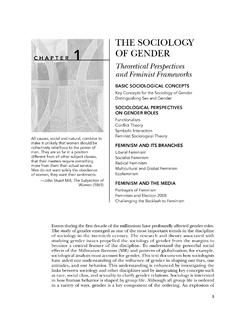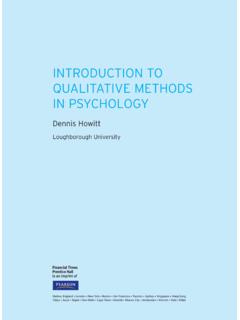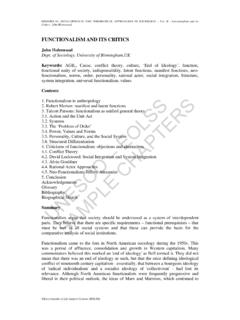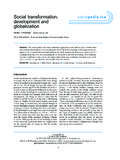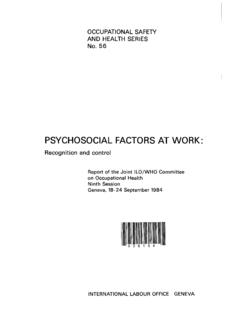Transcription of Chapter 1 Sociology: Perspective, Theory, and Method
1 Chapter 1. sociology : perspective , theory , and Method _____. Detailed Outline I. The Sociological perspective sociology is the systematic study of human society. At the heart of the discipline is a distinctive point of view called the sociological perspective , which involves a special kind of vision : A. Seeing the general in the particular The sociological perspective helps us to see general social patterns in the behavior of particular individuals. B. Seeing the strange in the familiar This perspective also encourages us to realize that society guides our thoughts and deeds. C. Seeing society in our everyday choices Emile Durkheim's research showed that the suicide rate was strongly influenced by the extent to which people were socially integrated with others. D. Seeing sociologically: marginality and crisis The greater people's social marginality, the better able they are to use the sociological perspective .
2 Just as social change encourages sociological thinking, sociological thinking can bring about social change. II. The Importance of a Global perspective A. Sociologists also strive to see issues in global perspective , defined as the study of the larger world and our society's place in it. B. There are three different types of nations in the world: 1. The world's high-income countries are industrialized nations in which most people have relatively high incomes. 2. The world's middle-income countries have limited industrialization and moderate personal income. 3. The world's low-income countries have little industrialization and most people are poor. 4. Global thinking is an important component of the sociological perspective for four reasons: a. Where we live makes a great difference in shaping our lives.
3 B. Societies the world over are increasingly interconnected, making traditional distinctions between us and them less and less valid. c. Many human problems faced in the United States are far more serious elsewhere. d. Thinking globally is a good way to learn more about ourselves. Copyright 2011 Pearson Education, Inc. All rights reserved. 1. Instructor's Manual for Macionis Society: The Basics, 11/e III. Applying the Sociological perspective Applying the sociological perspective benefits us in many ways: A. sociology and Public Policy Sociologists have helped shape public policy. B. sociology and Personal Growth Using sociology benefits us in four distinct ways: 1. The sociological perspective helps us assess the truth of common sense.. 2. The sociological perspective helps us assess both opportunities and constraints in our lives.
4 3. The sociological perspective empowers us to be active participants in society. 4. The sociological perspective helps us to live in a diverse world. C. Careers: The sociology Advantage . The application of sociology is evident in the role that sociology has had in shaping public policy and law in many ways. A background in sociology is also good preparation for the working world. An increasing number of sociologists work in all sorts of applied fields. IV. The Origins of sociology The birth of sociology resulted from powerful and complex social forces: A. Social Change And sociology Three major social changes during the seventeenth and eighteenth centuries are important to the development of sociology : 1. The rise of industrial technology 2. The growth of cities 3. Political change, including a rising concern with individual liberty and rights ( , the French revolution).
5 B. Science and sociology Auguste Comte believed that the major goal of sociology was to understand society as it actually operates. Comte saw sociology as the product of a three- stage historical development: 1. The theological stage, in which thought was guided by religion 2. The metaphysical stage, a transitional phase 3. The scientific stage The scientific stage would be guided by positivism: a scientific approach to knowledge based on positive facts as opposed to mere speculation. V. Sociological theory A theory is a statement of how and why specific facts are related. The goal of sociological theory is to explain social behavior in the real world. Theories are based on theoretical approaches, or basic images of society that guides thinking and research. Sociologists ask two basic questions: What issues should we study?
6 , and How should we connect the facts? There are three major sociological approaches: Copyright 2011 Pearson Education, Inc. All rights reserved. 2. Chapter 1 sociology : perspective , theory , and Method A. The structural-functional approach is a framework for building theory that sees society as a complex system whose parts work together to promote solidarity and stability. It asserts that our lives are guided by social structures (relatively stable patterns of social behavior). Each social structure has social functions, or consequences, for the operation of society as a whole. Key figures in the development of this approach include Auguste Comte, Emile Durkheim, Herbert Spencer, and Talcott Parsons. Robert Merton introduced three concepts related to social function: 1. manifest functions, or the recognized and intended consequences of any social pattern 2.
7 Latent functions, or largely unrecognized and unintended consequences 3. social dysfunctions, or undesirable consequences of a social pattern for the operation of society 4. Critical Review: The influence of this approach has declined in recent decades. It focuses on stability, ignoring inequalities of social class, race, and gender. B. The social-conflict approach is a framework for building theory that sees society as an arena of inequality, generating conflict and change. Most sociologists who favor this approach attempt not only to understand society, but also to reduce social inequality. Karl Marx is always associated with this approach. C. Feminism and the gender-conflict approach. One important type of conflict analysis is the gender-conflict approach: a point of view that focuses on inequality and conflict between men and women.
8 The gender-conflict approach is closely linked to feminism, the advocacy of social equality for women and men. D. The race-conflict approach. Another important type of social-conflict analysis is the race-conflict approach, a point of view that focuses on inequality and conflict between people of different racial and ethnic categories. 1. Critical Review: The various social conflict approaches have developed rapidly in recent years. They share several weaknesses: a. They ignore social unity based on mutual interdependence and shared values. b. Because they are explicitly political, they cannot claim scientific objectivity. c. Like the structural-functional approach, the social-conflict approaches envision society in terms of broad abstractions. E. The symbolic-interaction approach is a framework for building theory that sees society as the product of the everyday interactions of individuals.
9 The structural- functional and the social-conflict approaches share a macro-level orientation, meaning that they focus on broad social structures that shape society as a whole. In contrast, symbolic-interactionism has a micro-level orientation; it focuses on patterns of social interaction in specific settings. Key figures in the development of this approach include Max Weber, George Herbert Mead, Erving Goffman, George Homans, and Peter Blau. Critical Review: Symbolic interactionism attempts to explain more clearly how individuals actually experience society. However, it has two weaknesses: 1. Its micro-orientation sometimes results in the error of ignoring the influence of Copyright 2011 Pearson Education, Inc. All rights reserved. 3. Instructor's Manual for Macionis Society: The Basics, 11/e larger social structures.
10 2. By emphasizing what is unique, it risks overlooking the effects of culture, class, gender, and race. VI. Three Ways to Do sociology A. Scientific sociology One popular way to do sociological research is positivist sociology , which is the study of society based on scientific observation of social behavior. 1. Science Scientific knowledge is based on empirical evidence, meaning facts we verify with our senses. Sociological research often challenges what we accept as common sense. For example: a. It is often believed that the differences in the social behavior of women and men reflect human nature. In fact, much of what we call human nature is constructed by the society in which we live. b. It is often thought that the United States is a middle-class society in which most people are more or less equal.







